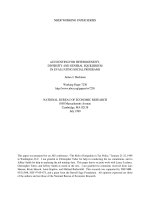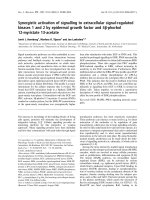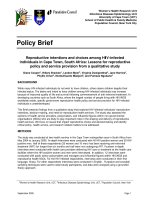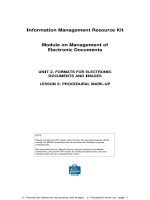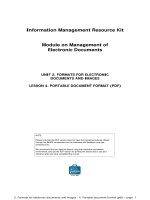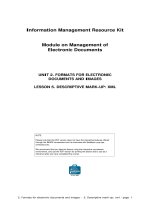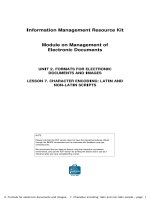UNIT 2. FORMATS FOR ELECTRONIC DOCUMENTS AND IMAGES LESSON 5. DESCRIPTIVE MARK-UP: XMLNOTE ppt
Bạn đang xem bản rút gọn của tài liệu. Xem và tải ngay bản đầy đủ của tài liệu tại đây (544.31 KB, 17 trang )
2. Formats for electronic documents and images - 5. Descriptive mark-up: xml - page 1
Information Management Resource Kit
Module on Management of
Electronic Documents
UNIT 2. FORMATS FOR ELECTRONIC
DOCUMENTS AND IMAGES
LESSON 5. DESCRIPTIVE MARK-UP: XML
© FAO, 2003
NOTE
Please note that this PDF version does not have the interactive features offered
through the IMARK courseware such as exercises with feedback, pop-ups,
animations etc.
We recommend that you take the lesson using the interactive courseware
environment, and use the PDF version for printing the lesson and to use as a
reference after you have completed the course.
2. Formats for electronic documents and images - 5. Descriptive mark-up: xml - page 2
At the end of this lesson, you will be able to:
• understand the features of descriptive mark-up;
• understand the structure of a well formed XML
document;
• understand the structure of a Document Type
Definition (DTD) and XML Schema;
• distinguish when an XML document is valid;
• know what the main stylesheets associated with XML
documents are.
Objectives
Descriptive mark-up consists of codes that
describe the logical structure and
semantics of a document, usually in a
way which can be interpreted by many
different software applications.
The two main open standards for descriptive
mark-up are SGML (Standard Generalized
Markup Language), published as a Standard
by the International Standards Organization
(ISO) in 1986, and XML (Extensible Markup
Language), which was published as a
Recommendation of the World Wide Web
Consortium (W3C) in 1998.
Descriptive Mark-up
2. Formats for electronic documents and images - 5. Descriptive mark-up: xml - page 3
The mark-up in an XML or SGML
document specifies the structure so that
the structure:
•is separated from the document
content,
•is logical, not presentation-oriented,
•can be processed (transformed)
easily,
•can be verified against a set of rules,
and
•is openly published, not owned by a
vendor.
Descriptive Mark-up
SGML and XML are very similar: when it was
originally published, XML was described as a profile
of SGML.
Both define the structure of a document as a set of
elements, nested one inside the other. In both
SGML and XML the mark-up consists of tags which
indicate where each element starts and ends.
However, XML is simpler and easier to use in
web-based applications.
Let’s look at some XML’s advantages…
Why use XML
<element A>
<element B>
<element C>
</element C>
</element B>
</element A>
2. Formats for electronic documents and images - 5. Descriptive mark-up: xml - page 4
With XML, different systems can communicate
with each other: XML is a cross-platform, software
and hardware independent format for exchange of
information between applications.
XML is also used as the source format from which to
generate other formats (Word, PDF, HTML, etc.),
since:
• it is an open, vendor neutral format,
• its mark-up captures the logical meaning of the
content,
• it is well defined with public specifications, and
• it is easy to transform to other formats.
Why use XML
XML
XML
Another interesting advantage of XML is the fact that its mark-up is understandable by both
humans as computers.
This is an XML document as it is displayed in the Internet Explorer web browser:
XML Documents
The browser lays out the
document showing the
nested tree of its
elements.
The small red dashes
you can see in front of
the book, chapter and
paragraph elements can
be clicked on to
collapse the tree at
that point.
2. Formats for electronic documents and images - 5. Descriptive mark-up: xml - page 5
The mark-up at the head of the document, enclosed in the <? … ?> tags, is called a processing
instruction. These are not part of the document content, but are specific instructions targeted
at applications which process the document.
In this case the
processing instruction
tells the XML processor
that we are using
version 1.0 of the XML
language standard and
the UTF-8 character
encoding.
Actually, this particular
processing instruction,
called the XML
Declaration, is included
at the top of most XML
documents.
XML Documents
The first element in our example document is the book element denoted by the start tag
<book> and end tag </book>. Since it contains all the other mark-up and content of our
document, it is the Base Document Element.
Every XML document must
have such a Base
Document Element (also
called the root).
The Base Document Element
can have any name that you
want, except anything
beginning with ‘xml’ which is
reserved for the use of the
xml standards themselves.
There are a few other rules
about the characters you can
use for names in XML –
check the specification for
details.
XML Documents
2. Formats for electronic documents and images - 5. Descriptive mark-up: xml - page 6
Some of the elements in our example contain attributes in their start tags, which are marked up
as name/value pairs (e.g., ISBN=attribute name, ‘1-2-3’=attribute value).
The <paragraph>
element is an example of
an element with mixed
content. It contains both
text and other elements
mixed together.
The <cite> element is an
example of an empty
element. It does not
have any content or/and
end tag. Empty element
are marked up, with a
forward slash just before
the closing > bracket in
the start tag.
XML Documents
An XML document is said to be well formed if it follows the basic rules of XML syntax.
Some of the most important constraints are:
Well Formed XML Documents
The ‘well-formedness constraints’ are specified in the W3C XML recommendation of 1998.
No attribute name may appear more than once in the same start-tag or
empty-element tag.
The name in an element's end-tag must match the element type in the
start-tag.
Production rules including: start and end tags for elements must be
properly nested, and attribute values must be quoted.
<element>
</element>
attribute value
<elementA…>
</elementA>
<elementA
attributeX=
attributeX=
attributeY= >
2. Formats for electronic documents and images - 5. Descriptive mark-up: xml - page 7
Software which checks
whether an XML document is
well formed is called a non-
validating parser.
On the left, you can see a
typical software application
(an XML Editor) which has a
non-validating parser. In this
example, our document is not
well formed since the second
title element should be closed
before the chapter element.
Well Formed XML Documents
Scelta multipla
Now, can you indicate which of these fragments is part of a well-formed document?
<book ISBN= “1-2-3” Author=“Fred
Pratt” Pubdate= “02-01-2001”>
<title>XML</title>
<chapter> <title>My XML</title>
<paragraph type= “block”>This is my
XML document</paragraph>
</chapter>
</book>
<book ISBN= “1-2-3” Author=“Fred
Pratt” Pubdate= “02-01-2001”>
<title>XML</title>
<chapter> <title>My XML</title>
<paragraph type= “block”>This is my
XML document</chapter>
</paragraph>
</book>
<book ISBN= “1-2-3” Author=“Fred
Pratt” Author=“James Ricci”
Pubdate= “02-01-2001”>
<title>XML</title>
<chapter> <title>My XML</title>
<paragraph type= “block”>This is
my XML document</paragraph>
</chapter>
</book>
Well Formed XML Documents
Click on the answer of your choice
2. Formats for electronic documents and images - 5. Descriptive mark-up: xml - page 8
XML provides an application independent way of
sharing data. So, it is important to create
standardized documents, that can be easily
understood by other applications.
Besides following the basic rules of XML syntax, we
can also use a set of rules which specify the logical
structure that is allowable for a particular type of
document (e.g. a book).
With these rules, each of your XML files can carry a
description of its own format with it.
Standard for specifying these rules in an XML
document are:
• Document Type Definition (DTD)
• W3C XML Schema
Let’s look at each of them…
DTD and XML Schema
The DTD is included in the original XML recommendation published by the W3C in 1998.
It contains declarations for the elements and attributes that can be used to mark up the
particular type of document, in our example a book.
To associate a DTD with an XML document instance we include a DOCTYPE declaration at the
head of our document, as shown in our example.
The SYSTEM keyword is followed by a URI which specifies the network location (a file) where the
DTD can be found.
DTD and XML Schema
2. Formats for electronic documents and images - 5. Descriptive mark-up: xml - page 9
Here, you can see the DTD in its plain text form opened in a text editor.
It defines what tags appear in the XML document, what attributes the tags may have and what a
relationship the tags have with each other.
Element declarations are
enclosed in the delimiters <! …>
and start with the ELEMENT
keyword, followed by the name
of the element being declared
and its content model in
brackets ().
Attribute declarations are
enclosed in <! …> and start with
the ATTLIST keyword, followed
by the name of the element for
which attributes are being
defined and sets of triples that
specify an attribute name, its
data type and a possible
default value.
DTD and XML Schema
The W3C XML Schema fulfills the same function as DTDs did in the original specification, but
extends the capabilities of DTDs, particularly in the areas of data typing and specification of
constraints on the values of attributes and element content.
Our XML document shows how a schema can be associated with an XML document by including
two additional attributes in the start tag of the base document element:
DTD and XML Schema
2. Formats for electronic documents and images - 5. Descriptive mark-up: xml - page 10
Here’s a fragment (about a quarter) of the XML schema that defines the structure of our simple
<book> document. As you can see, it is very different from an XML DTD!
The XML schema is
itself an XML
document, and it
contains a lot of
mark-up.
In fact, it can be
created by tools such
as XML Spy.
DTD and XML Schema
When an XML document is processed, it is compared with the DTD to be sure it is structured
correctly and all tags are used in the proper manner.
This comparison process is called validation and it is performed by a tool called a validating
parser.
Valid XML Documents
In the following example, the validating parser has detected that the document is not conform to
the specified DTD (since in a book document the chapter element must be followed by the title
element).
2. Formats for electronic documents and images - 5. Descriptive mark-up: xml - page 11
To summarize, the DTD and XML schema are
rules to produce valid XML documents.
rules to produce well-formed XML documents.
verified by a non-validating parser.
verified by a validating parser.
Valid XML Documents
Please select the options of your choice (2 or more) and
press Check Answer
Cascading Style Sheets
As you already know, descriptive mark-up
describes the logical structure: it says nothing
about how a document should be
displayed in a web browser or on the printed
page.
The information required to do that can be
stored in a separate stylesheet which
contains the rendering instructions.
One of the simplest ways to render an XML
document directly in a web browser is to
create a Cascading Style Sheet (CSS).
Originally developed for use with HTML, CSS
can be used directly with XML as well.
Some other XML applications such as editing packages
may also support CSS.
The first version of Cascading Style Sheets, CSS 1.0, was
published as a Recommendation by the W3C in 1996 (see
www.w3.org/TR/REC-CSS1). A subsequent version,
CSS 2, was released in 1998, but it is not universally
supported by software vendors. Although it contains some
useful features not in CSS 1, it should be used with
caution.
2. Formats for electronic documents and images - 5. Descriptive mark-up: xml - page 12
Cascading Style Sheets
A Cascading Style
Sheet contains
formatting
instructions for the
elements in the
document.
It can be associated
with an XML
document by
including the xml-
stylesheet processing
instruction in the
document.
Here you have an
example of an XML
document, its
associated style sheet
and the result when
the document is
loaded in the IE5 web
browser.
Cascading Style Sheets
RESULT
2. Formats for electronic documents and images - 5. Descriptive mark-up: xml - page 13
XSLT
The Extensible Stylesheet Language
for Transformations (XSLT) is a
Stylesheet language for XML.
An XSLT stylesheet is itself an XML
document, containing templates that
match against elements or attributes in
the source document. Each template
contains a set of rules which specify the
output to be generated when the
template is matched.
The figure shows a simple XML document
and part of its associated XSLT
stylesheet.
XSLT
RESULT
2. Formats for electronic documents and images - 5. Descriptive mark-up: xml - page 14
XSLT
An XSLT processor takes as its
input an XML source document
and its associated stylesheet and
generates the output as specified
in the stylesheet.
The most common
transformation is from arbitrary
XML mark-up into HTML for
display in a web browser, but in
fact, any output format can be
generated.
Most web browsers now have
XSLT processors built-in, and so
can display an XML document
rendered directly with its
stylesheet.
The Extensible Stylesheet Language for Transformations (XSLT) was published as a Recommendation of the W3C
in 1999.
Implementations of XSLT processors have been written in many languages (Java, C++, Perl, etc) and are freely
available as open source software. Two of the most widely used are called Saxon ()
and Xalan ().
Summary
• XML, born as a profile of SGML, is an open standard for descriptive
mark-up, used as exchange format between applications.
• An XML document is well formed if it follows the basic rules of XML
syntax.
• Document Type Definition (DTD) and XML Schema are sets of
rules which specify the logical structure that is allowable for a
particular type of document.
•An XML document is valid if it complies with the rules set out in a DTD
or XML Schema with which it is associated.
• A Cascading Style Sheet (CSS) is a separate stylesheet which
contains simple rendering instructions for a XML document.
• Extensible Stylesheet Language for Transformations (XSLT) is
used to create stylesheets which define transformations from XML to
other XML or non-XML formats.
2. Formats for electronic documents and images - 5. Descriptive mark-up: xml - page 15
Exercises
The following four exercises will help you test your understanding of the concepts covered in the
lesson and will provide you with feedback.
Good luck!
What differentiates XML from SGML ?
Exercise 1
It describes a logical structure of a document.
It is openly published.
It is easy to use in web-based applications.
Click on the answer of your choice
2. Formats for electronic documents and images - 5. Descriptive mark-up: xml - page 16
What is the required condition to obtain a well-formed XML document?
That it follows the basic rules of XML syntax.
That it follows the rules of DTD or XML schema.
Exercise 2
Click on the answer of your choice
Exercise 3
It specifies the structure of a a particular type of an XML document
It is a file external to an XML document.
It is itself an XML document.
Click on the answer of your choice
What differentiates XML schema from DTD?
2. Formats for electronic documents and images - 5. Descriptive mark-up: xml - page 17
Can you indicate the features corresponding to each kind of stylesheet?
Cascading Style Sheet
(CSS).
Extensible Stylesheet
Language for
Transformations (XSLT)
It was originally developed for use
with HTML
It was originally developed for use
with XML
It is itself an XML document
It is not itself an XML document
1
a
Exercise 4
If you want to know more
•Information Processing -Text and Office Systems - Standard Generalized
Markup Language (SGML)", ISO 8879:1986. (www.iso.ch/cate/d16387.html)
•World Wide Web Consortium (www.w3.org). Open information standards for the
Web, including the XML, XML Schema, CSS and XSLT specifications.
•XML.com – an online magazine and portal to XML information (www.xml.com)
•OASIS – the Organization for the Advancement of Structured Information
Standards (www.oasis-open.org)
•www.xmlhack.com - an online magazine, similar to xml.com but tending to be
more controversial in its views
•ebXML - an open XML-based infrastructure enabling the interchange of
electronic business information globally (www.ebxml.org)
•Apache Software Foundation XML project – open source software tools for XML
(xml.apache.org)
•The XML Companion (3rd Edition) by Neil Bradley. Addison Wesley Professional.
ISBN: 0201770598
•XSLT Quickly by Bob Ducharme. Manning Publications Company; (July 2001)
ISBN: 1930110111
•Saxon and Xalan, two of the most widely used implementations of XSLT, freely
available as open source software ( and
/>
